Work is continuing towards Robert Bussard’s vision of inertial electrostatic fusion.
digg_url = ‘http://advancednano.blogspot.com/2007/11/fusion-propulsion-if-bussard-iec-fusion.html’;
digg_topic = ‘Space’;
reddit_url=’http://advancednano.blogspot.com/2007/11/fusion-propulsion-if-bussard-iec-fusion.html’
reddit_title=’Carnival of Space #30′
UPDATE: Tom Ligon wrote the slides and gave the speech which presented this material.
Fusion R&D
Phase 1 – Validate and Review WB-6 Results
The proposed WB-7 and WB-8 devices will be constructed and tested during 2008.
1.5 – 2 years (by the end of 2008), $3-5M
Fusion R&D
Phase 2 – Design, Build and Test
Full Scale 100 MW Fusion System
5 years (2009-2013), $200M
If the full commercial system is successful then from 2014-2029+ there would the development of nuclear fusion enabled space vehicles.
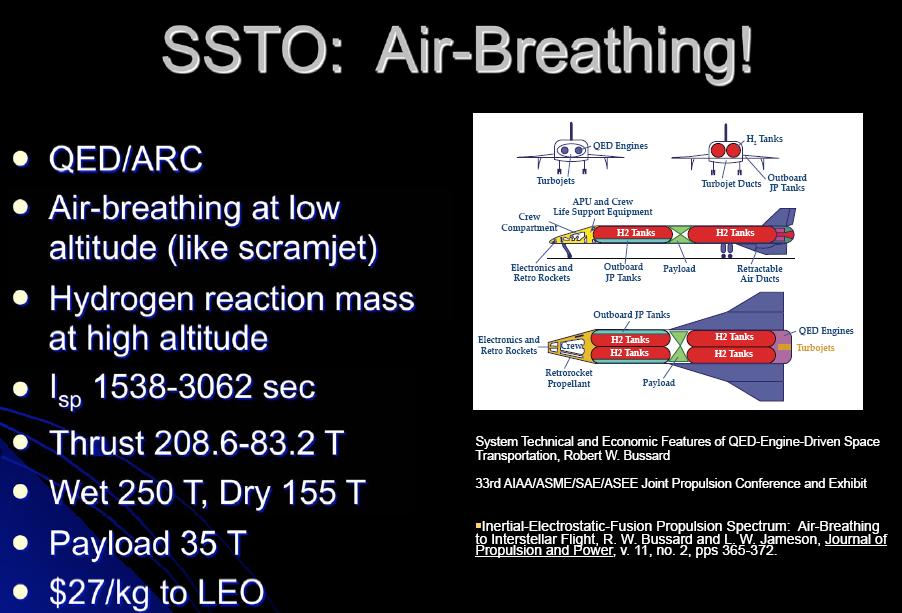
Two 8 gigawatt Thermal fusion engines power this vehicle. The cost estimate is 100 times less than the best system available now.
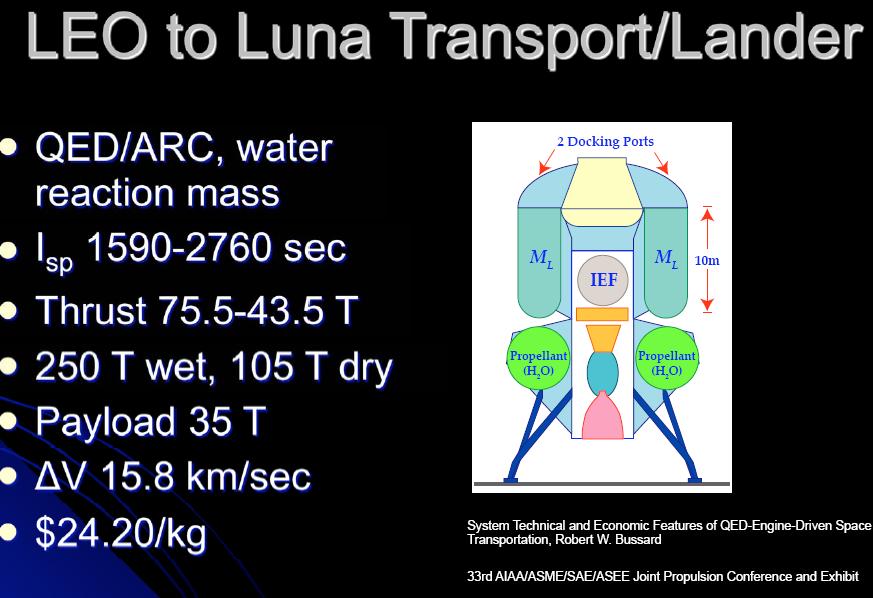
20 hours to go from the low earth orbit to lunar orbit. 24 hours to go from the earth surface to the lunar surface using these systems.

These vehicles would have three main types of fusion engines. The DFP, CSR (controlled space radiator) and ARC which are shown with different ISP and thrust levels. CSR and ARC are Quiet Electric Discharge (QED) engines with ISP in the 1500 to 70000 range. They use arcjet heating of reaction mass.
DFP are diluted fusion product engines. They have high ISP 50,000 to 1.2 million. Reaction mass added to fusion product directly from the reactor.
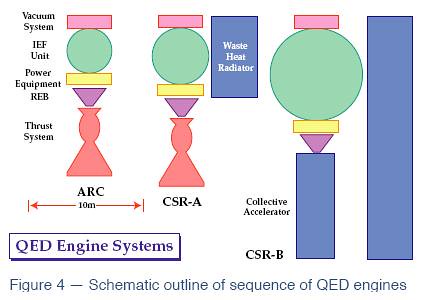
Here are block diagrams of the QED engine types
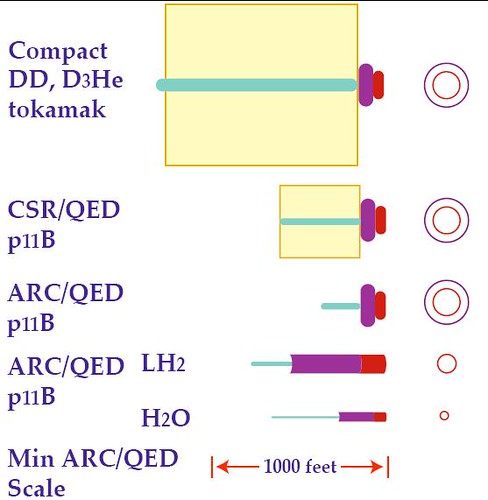
Here are long range space vehicle sizing with the different engine types. The Bussard rockets are about 1 to 2 football fields long.
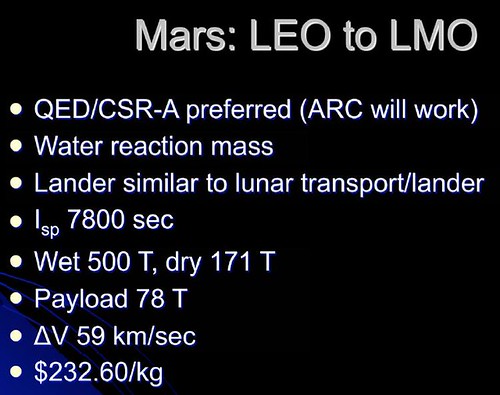
Description of Mars Bussard fusion vehicle. 33-38 days to Mars one way.
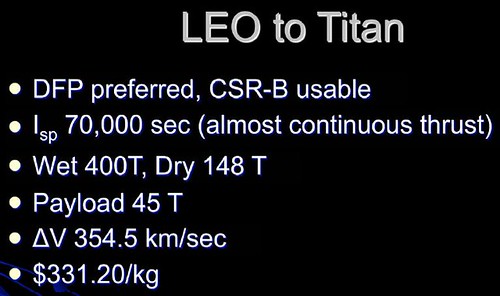
Description of a vehicle to go to Saturn’s moon Titan.
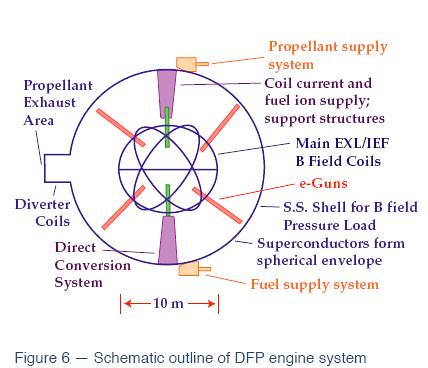
Diluted fusion product (DFP) engine schematic

Fusion rocket schematic for Titan mission. Each way would take 75-90 days.
The vehicles will enable large and inexpensive space colonies.
Lunar colony
4000 people, 25 tons each, $12.5 billion (1997 estimate)
Mars colony
1200 people, 50 tons each, $15.6 billion
Titan colony
400 people, 60 tons each, $16.2 billion

Why the colonies and vehicles are relatively cheap
If we have the relatively lightweight working fusion reactors with power ranges up to 10 gigawatts or more each, then all sorts of space propulsion becomes possible.
The fusion reactors could power massive laser arrays or high powered minimag Orion style propulsion systems.
If the Bussard inertial electrostatic fusion reactors work out we would redesign everything. All of the navy and military vehicles and our entire civilization. Even these first designs would give flights to the moon and orbit equal to about the price of old Concorde airplane tickets.
FURTHER READING
2006 space conference notes on Bussard fusion rockets
The 2007 power point presentation with most of the slides for this article
A paper describing inertial electrostatic fusion propulsion
Robert Bussard on inertial electrostatic fusion.
This project had been funded again by the US Navy
Askmar has links to the scientific papers on the Fusion concept

Brian Wang is a Futurist Thought Leader and a popular Science blogger with 1 million readers per month. His blog Nextbigfuture.com is ranked #1 Science News Blog. It covers many disruptive technology and trends including Space, Robotics, Artificial Intelligence, Medicine, Anti-aging Biotechnology, and Nanotechnology.
Known for identifying cutting edge technologies, he is currently a Co-Founder of a startup and fundraiser for high potential early-stage companies. He is the Head of Research for Allocations for deep technology investments and an Angel Investor at Space Angels.
A frequent speaker at corporations, he has been a TEDx speaker, a Singularity University speaker and guest at numerous interviews for radio and podcasts. He is open to public speaking and advising engagements.

1 thought on “Fusion propulsion if Bussard IEC fusion works”
Comments are closed.